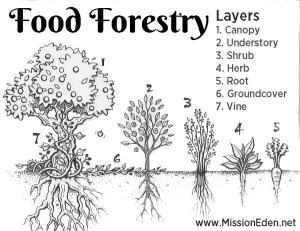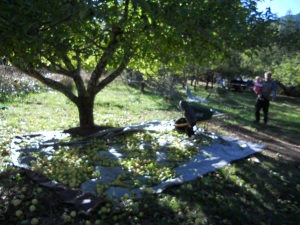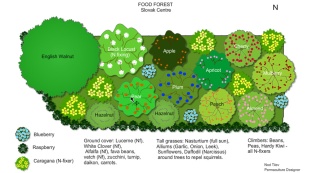Food forests mimic nature by placing multiple species plants in mutually supportive relationships. This creates a diverse ecosystem that provides diverse products for humans and enhances the local ecology. Food forests are primarily comprised of perennial crops which require less energy to grow and do not require distrubing the soil each year as annual crops do.

Each plant in a food forest provides multiple functions to the system. Some plants fix nitrogen supplying free fertilizer to other plants, some plants drop their leaves supplying free mulch which builds the soil and conserves water, some plants support pollinators, some plants produce food and medicine, some plants provide share, some plants send their roots far down into the Earth to bring up water and nutrients that other plants can use.
A Holistically Integrated Solution:
1. Socially Responsible: The potential for a worldwide food crisis because of dependence on large-scale corporate agriculture is now widely acknowledged. Facing current trends including extreme weather, rising food prices, rising demand, and speculation, planting food forests to supply food to local communities is perhaps the most socially responsible action we can take. Small scale community food forests have the potential to bring communities together and increase access to food and resilience in uncertain times. Already public food forests and fruit tree planting projects are sprouting worldaround. A single apple tree costing $10 if cared for will grow to yield 48,000 apples. At $0.50/lb. this is $24,000 worth of healthy food. What other investment promises such a return?

2. Economically Viable: Polyculture (multiple crop) food production is an economically viable system with greater productivity that typical monoculture farming. In addition, food forests rely on perennial crops that can be propagated for free from cuttings or saving seed. The potential for sharing plant stock and other resources through grassroots community networks will amplify the economic viability of food forests.
“On approximately two acres— half of which was on a terraced 35 degree slope—I produced enough food to feed more than 300 people, 49 weeks a ¬¬¬year in my fully organic CSA on the edge of Silicon Valley. I did this for almost nine years until I lost the lease to my rented land. My yields were often 8 times what the USDA claims are possible per square foot. My soil fertility increased dramatically each year… I built my soil from cement-hard adobe clay to its impressive state from scratch.” (Blume)
3. Environmentally Sound: Food forests present a sustainable alternative to modern food production practices. The food forest model:

- Promotes bio-diversity by planting multiple crop species together;
- Eliminates need for chemical pesticides, herbicides, and fertilizers;
- Increases soil fertility over time through use of specific plant species that:
- fix nitrogen (providing a natural living plant fertilizer),
- provide mulch (through dropping of leaves), and
- cycle nutrients through the system (i.e. deep root species),
- Supports pollinators,
- Regulates pests and disease naturally,
- Requires no tilling after the initial planting, thus conserving soil fertility and protecting soil physiochemical and biological processes, and
- Eventually eliminates fossil fuel consumption in food production. After the initial 10 years food forests require minimal human labor and after 20 years are self-functioning forest ecosystems that continue to provide food and other useful crops and resources.
[…] Source: What’s a Food Forest? | Mission Eden […]
LikeLike